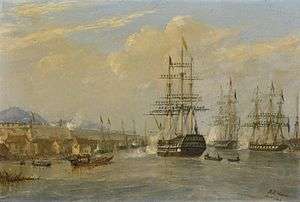HMS Cornwallis (1813)
 HMS Cornwallis and the British squadron in China | |
| History | |
|---|---|
| Name: | HMS Cornwallis |
| Ordered: | 25 July 1810 |
| Builder: | Jamsetjee Bomanjee Wadia, Bombay Dockyard |
| Laid down: | 1812 |
| Launched: | 12 May 1813 |
| Fate: | Broken up, 1957 |
| General characteristics [1] | |
| Class and type: | Vengeur-class ship of the line |
| Tons burthen: | 1809 bm |
| Length: | 176 ft (54 m) (gundeck) |
| Beam: | 47 ft 6 in (14.48 m) |
| Depth of hold: | 21 ft (6.4 m) |
| Propulsion: | Sails |
| Sail plan: | Full rigged ship |
| Armament: |
|
HMS Cornwallis was a 74-gun third rate ship of the line of the Royal Navy, launched on 12 May 1813 at Bombay.[1] She was built of teak. The capture of Java by USS Constitution delayed the completion of Cornwallis as Java had been bringing her copper sheathing from England.[2]
On 27 April 1815, Cornwallis engaged the American sloop USS Hornet, which had mistaken the Cornwallis for a merchant ship. Heavily outgunned, the Hornet was forced to retreat. The crew threw boats, guns and other equipment overboard in order to escape.[3]
After China's defeat in the First Opium War, representatives from the British and Qing Empires negotiated a peace treaty aboard Cornwallis in Nanjing. On 29 August 1842, British representative Sir Henry Pottinger and Qing representatives, Qiying, Ilibu and Niujian, signed the Treaty of Nanking aboard her.
Cornwallis was fitted with screw propulsion and reduced to 60 guns in 1855,[1] and took part in the Crimean War, where she was commanded by George Wellesley, future admiral and First Sea Lord, and the nephew of the Duke of Wellington.
She was converted to a jetty at Sheerness in 1865. In 1916 she was renamed HMS Wildfire and used as a base ship. She was finally broken up in 1957 at Sheerness, some 144 years after her launching.[1]
Notes
References
- Colledge, J. J.; Warlow, Ben (2006) [1969]. Ships of the Royal Navy: The Complete Record of all Fighting Ships of the Royal Navy (Rev. ed.). London: Chatham Publishing. ISBN 978-1-86176-281-8. OCLC 67375475.
- James, William (1837), The Naval History of Great Britain, from the Declaration of War by France in 1793, to the Accession of George IV., R. Bentley
- Lavery, Brian (2003) The Ship of the Line - Volume 1: The development of the battlefleet 1650-1850. Conway Maritime Press. ISBN 0-85177-252-8.
- Parkinson, C. Northcote (1954) War in the Eastern Seas, 1793-1815. (London: George Allen & Unwin), p. 421.